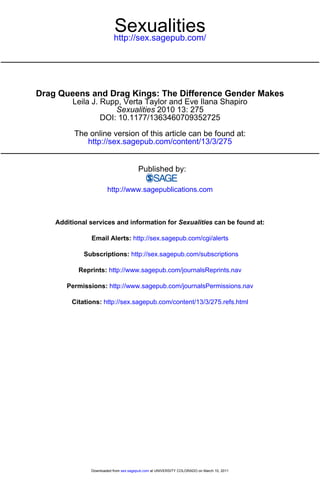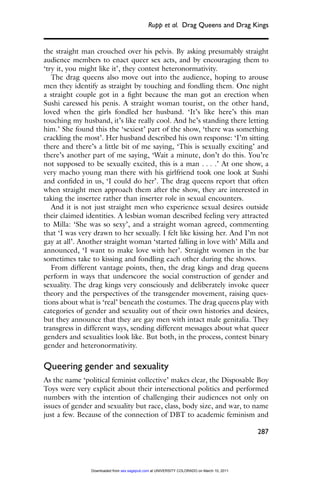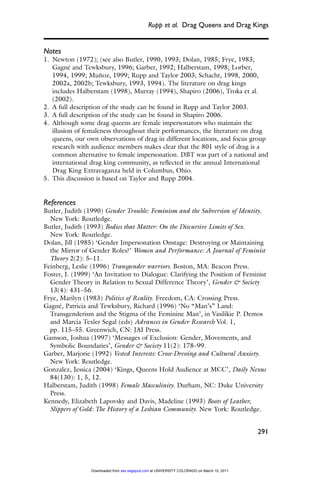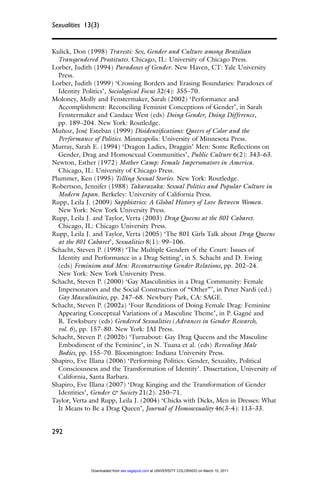This document provides an abstract and introduction to an article that compares drag queens and drag kings. It summarizes a panel discussion between drag queens from Key West, Florida and drag kings from Santa Barbara, California that highlighted some differences in their approaches. While both critique gender norms through performance, the drag kings engaged more with feminist and gender theory and took a more overtly political stance, whereas the drag queens were more campy and outrageous. The article aims to systematically compare drag queens and drag kings, exploring how they came to drag performance, the contexts of their shows, and how their performances similarly challenge heteronormativity, despite differences.









![Rupp et al. Drag Queens and Drag Kings
suggests, the drag kings also moved in a world shaped by exposure to
queer theory and activism.
For Mike Hawk, a member who was working as an administrative
assistant at the university and came to identify as transgender during his
participation, DBT was a place of discovery around his own gender.
I wasn’t out as trans when I joined DBT or when I started getting interested,
but there was something about going in drag that was really appealing and
something about being in this male character that was comfortable for me. [I
was] able to experience this other gender, this male gender that now I under-
stand was fitting my identity, but at the time I didn’t really understand that.
In addition to members who came to identify with masculine gender
identities, female members understood their normative-appearing
feminine identities in new ways.
All members, including those who felt that they had made conscious and
deliberate choices about their gender presentations prior to DBT, never-
theless came to think deeply about gender. For some feminine members
the community and culture of DBT opened up new identities. Venus Envy,
an undergraduate student at UC Santa Barbara, began DBT feeling
securely woman identified, but over time, ‘I came to identify as femme and
I came to be very butch femme oriented when I was never that way before.
It definitely had to do with the troupe dynamics’. Dylan, who joined as an
undergraduate and remained femme identified, described a similar shift in
self-understanding, elaborating that ‘when I started doing drag I realized
there were so many questions I hadn’t even dared to ask myself and so
many things that I hadn’t tried or been open to at all’. What these
comments by Venus Envy and Dylan reflect, and what many other
members expressed, is that participants’ understanding of how they could
be gendered broadened beyond the academic understanding they brought
to drag kinging through doing drag with DBT.
The more nuanced gender identities that members came to embrace
were reflected in a linguistic shift away from the language of male and
female to a continuum of masculinity and femininity. For example, when
describing how DBT affected him Rian Hunter, a member who began
DBT female-identified and became transgender-identified over time,
reflected that, ‘I am more ambiguous, more whatever, I just am who
I am . . . you don’t have to be in a box about anything’. Instead of
accepting normative genders, members described specific and complex
identities. For example, femininities might be ‘chosen’, ‘proud’, and ‘trans-
gressive’, expressed as ‘radical femininity’, ‘femme’, ‘genderqueer-femme’,
‘androgynous female’ and ‘de facto female’.
An even more striking expansion happened around masculinities. As
more members identified as transgender or genderqueer, they claimed
283
Downloaded from sex.sagepub.com at UNIVERSITY COLORADO on March 10, 2011](https://image.slidesharecdn.com/dragqueensanddragkingsnotes-110405224759-phpapp01/85/Drag-Queens-and-Drag-Kings-The-Difference-Gender-Makes-10-320.jpg)
![Sexualities 13(3)
labels such as ‘butch’, ‘ambiguous masculinity’, ‘masculine female’ and
‘female-to-male transsexual’. As part of their broadening of female
masculinities, some participants drew connections to histories of butch-
ness, while others thought that continuing to call themselves ‘women’ was
a political act. Nate Prince, an undergraduate butch Asian Pacific Islander,
talked about a solo performance he created to female vocals. ‘I did the
India Arie song [Video] to say I don’t wear pantyhose, I don’t shave my
legs all of the time, and I don’t look like a supermodel but I’m still a
woman. I wore my boxers and [men’s undershirt] and showed here are
ways to be a woman.’
The political feminist ideology of the group manifested as an effort to
resist binary gender classifications. Often, members had to be pushed to
name a singular gender identity, and then they generally qualified these
namings with caveats such as, ‘If I have to choose’, or ‘I guess I am’.
Throughout their discussions of identity, DBT members talked about
gender as constructed and intentionally chosen rather than natural, and
made sense of their own changes as outcomes of participation in DBT.
Summer’s Eve, a graduate student and bio queen, noted: ‘We joke in
DBT about drag being the gateway drug for gender regardless of what
that gender is. Some members came into a masculine butch, some
members came into a female identified butch, and some members came
into fiercely femme.’
What is striking is that participation in DBT facilitated self-reflexivity
about gender identity at a very high level, which led to significant changes
in the identities members claimed. The drag queens did not experience
the same kind of questioning about gender as a result of their perform-
ances; rather, gender transgression played an important part in bringing
them to drag, but they did not develop the same kind of complicated
gender identities and analysis. This is no doubt in part, at least, because
of the different histories of drag queens and drag kings in the gay and
lesbian community. Young men who have feminine tendencies have a
readily available model – drag queens – that they can embrace, even
though the sanctions imposed on men who wear women’s clothing under
normal circumstances are far more severe than those applied to women
who adopt masculine attire. Drag, through its association with camp,
has historically been an assertion of gay existence. Drag kinging is a
relatively recent phenomenon, although there is of course a long
history of masculinity associated with female same-sex desire, including
gender-crossing women and butch/fem communities (Feinberg. 1996;
Halberstam, 1998; Kennedy and Davis. 1993; Rupp, 2009). In any case,
these different positions – a visceral response to effeminacy and sexual
desire versus a theoretically sophisticated critique of gender – lead to
contrasting modes of performing gender and sexuality.
284
Downloaded from sex.sagepub.com at UNIVERSITY COLORADO on March 10, 2011](https://image.slidesharecdn.com/dragqueensanddragkingsnotes-110405224759-phpapp01/85/Drag-Queens-and-Drag-Kings-The-Difference-Gender-Makes-11-320.jpg)



![Sexualities 13(3)
queer theory, the troupe developed a consciously anti-racist perspective,
leading them not to perform numbers in which White performers lip-
synched to songs by musicians of color. As a result, some members of the
Santa Barbara community, as well as DBT members of color, critiqued
the troupe’s repertoire as ‘too White’. Presentations of gender and sexual
fluidity were central to their performances. Kentucky Fried Woman, a
graduate student who joined as a bio queen and remained femme-
presenting, drew on the troupe’s understanding of gender as always
performative to make sense of gender transgression – what she and others
called a genderqueer identity – as intentional gender play. She stated:
I believe that me and the people I perform with . . . my friends, my community,
we’re gender outlaws. We refuse to be placed in a box that says this is what
we’re born as, this is what we are. We play with it. And the more we play with
it the more I feel like the fucked up foundations that our whole society is built
on are going to crumble.
Regardless of outward gender presentation, identifying as a gender outlaw
became a political act through resistance to hegemonic gender norms.
Although our research did not explicitly explore the impact of drag king
performances on audiences, the connections between audience members
and performers – especially in local queer venues – were close enough to
know something about audience reaction to the political messages of drag
kinging. As Bill Dagger, an African American graduate student who
identified as a genderqueer butch dyke, explained, DBT ‘gives a way for
the audience to express desire towards people that they might otherwise
not be inclined to express in public’. In contrast to the drag queens, who
engaged in sexual touching and fondling as a way to arouse unaccustomed
desires, the drag kings developed a critique of such practices. At the same
time, they recognized the potential of the kind of tactics embraced by the
drag queens. As Summer’s Eve explained, gay men in the audience were
sometimes turned on by butch members on stage.
Sometimes it was really inappropriate; they were very grabby and touchy in ways
that were just appalling to some of our members. But it was also very interest-
ing and fascinating to see these guys who are so about the cult of masculinity.
That gets troubled when you get a hard-on for a drag king and you know that
the plumbing up there isn’t the plumbing that you desire . . . I would say that
DBT has been a force for counteracting misogyny in the queer community.
Roman Hands, a graduate student who joined as transgender-identified,
put it this way:
When DBT performs for an audience . . . there is a certain amount of eroticism
of us by the audience [and this] pushes their boundaries . . . When you put two
people up on stage and they are both performing a gay male persona, one of
them may live their life as a woman and one of them as a gay man. [What
288
Downloaded from sex.sagepub.com at UNIVERSITY COLORADO on March 10, 2011](https://image.slidesharecdn.com/dragqueensanddragkingsnotes-110405224759-phpapp01/85/Drag-Queens-and-Drag-Kings-The-Difference-Gender-Makes-15-320.jpg)
![Rupp et al. Drag Queens and Drag Kings
happens when] someone in the audience is attracted to both of them and that
person thought they were straight? It makes people question themselves and
any of the strict biases and prejudices they have in their head because they see
it in themselves, then.
From an entirely different perspective, the drag queens also challenge
hegemonic masculinity and heteronormativity. Although none of them
have read Judith Butler, they, too, get across to audiences the per-
formativity of gender and the fluidity of sexuality, race and ethnicity. They
see themselves as challenging their audiences and raising consciousness.
As Milla put it, ‘We are attractive to everybody. We have taken gender and
thrown it out of the way, and we’ve crossed a bridge here. And when we
are all up there, there is no gay/straight or anything.’ Race, ethnicity, and
class are also explicit in their performances, but in a complicated way. On
the one hand, the drag queens deploy the tradition of camp humor, which
can be read as self-denigrating and incompatible with assertions of gay
pride (Newton, 1972). Sushi, for example, asked the audience to call her
a ‘nip’, ‘gook’, and ‘chink’ and deliberately played on stereotypes of Asian
sexuality, and Destiny identified as ‘white trash’ while performing Harper
Valley PTA. On the other hand, the drag queens embrace a more fluid
conception of race and ethnicity when they engage in what Robertson
(1988) calls ‘cross-ethnicking’: Gugi performed as Cuban or Mexican as
well as Puerto Rican, and Milla, whom the other girls called a ‘Black
woman trapped in a White male body’, favored numbers by Black women.
The strategies of both the drag queens and drag kings – with profoundly
different theoretical foundations – called attention to racial, ethnic and
class difference, appealing to some audience members but not others.
And in fact, as focus group members made clear, their message got
across. One gay man concluded that the labels of ‘gay’ and ‘straight’, like
‘man’ and ‘woman’, just do not fit: ‘You leave them at the door’. Said
another, the drag queens are ‘challenging the whole idea of gender and
so forth and they’re breaking that down’. A straight male tourist put it
this way: ‘I think that one of the beauties of attending a show like this is
that you do realize that you . . . shouldn’t walk out and say, “I only like
men”, and you shouldn’t say “I only like women”, and it all kind of blends
together a lot more so than maybe what we want to live in our normal
daily lives.’
Despite fundamental differences between the drag queens and drag
kings, both troupes make a real impact on people’s thinking about the
boundaries of gender and sexuality. They bring people together, blur the
lines of gender, and arouse unaccustomed sexual desires. The drag kings
consciously embody a queer theory perspective, but the drag queens,
without the language of social constructionism or gender performativity,
trouble gender and sexuality in similar ways.
289
Downloaded from sex.sagepub.com at UNIVERSITY COLORADO on March 10, 2011](https://image.slidesharecdn.com/dragqueensanddragkingsnotes-110405224759-phpapp01/85/Drag-Queens-and-Drag-Kings-The-Difference-Gender-Makes-16-320.jpg)



![Rupp et al. Drag Queens and Drag Kings
Taylor, Verta and Whittier, Nancy (1992) ‘Collective Identity in Social
Movement Communities: Lesbian Feminist Mobilization’, in A. Morris and
C. Mueller (eds) Frontiers in Social Movement Theory, pp. 104–30.
New Haven, CT: Yale University Press.
Tewksbury, Richard (1993) ‘Men Performing as Women: Explorations in the
World of Female Impersonators’, Sociological Spectrum 13(4): 465–86.
Tewksbury, Richard (1994) ‘Gender Construction and the Female
Impersonator: The Process of Transforming “He” to “She”’, Deviant
Behavior: An Interdisciplinary Journal 15(1): 27–43.
Troka, Donna, LeBescoe, Kathleen and Noble, Jean (Eds) (2002) The Drag
King Anthology. New York: Harrington Park.
Valentine, David (2003) ‘“I went to Bed with my Own Kind Once”: The
Erasure of Desire in the Name of Identity’, Language & Communication
23(2): 123–38.
Valocchi, Stephen (2005) ‘Not Yet Queer Enough: The Lessons of Queer
Theory for the Sociology of Gender and Sexuality’, Gender & Society 19(6):
750–70.
Volcano, Del LaGrace and Judith ‘Jack’ Halberstam (1999) The Drag King
Book. London: Serpent’s Tail.
Biographical Notes
Leila J. Rupp is Professor of Feminist Studies and Associate Dean of Social
Sciences at the University of California, Santa Barbara. She is co-author, with
Verta Taylor, of Drag Queens at the 801 Cabaret (2003) and Survival in the
Doldrums: The American Women’s Rights Movement, 1945 to the 1960s (1987)
and author of A Desired Past: A Short History of Same-Sex Sexuality in America
(1999), Worlds of Women: The Making of an International Women’s Movement
(1997), and Mobilizing Women for War: German and American Propaganda,
1939–1945 (1978). Her most recent book is Sapphistries: A Global History of
Love Between Women (2009). Address: Department of Feminist Studies,
University of California, Santa Barbara, CA 93106–7110.
[email: lrupp@femst.ucsb.edu]
Verta Taylor is Professor and Chair of the Department of Sociology at the
University of California, Santa Barbara. She is co-author with Leila J. Rupp of
Drag Queens at the 801 Cabaret (University of Chicago Press) and Survival in
the Doldrums: The American Women’s Rights Movement, 1945 to the 1960s
(Oxford University Press); co-editor of 8 editions of Feminist Frontiers; and
author of Rock-a-by Baby: Feminism, Self-Help and Postpartum Depression
(Routledge). Her articles have appeared in journals including The American
Sociological Review, Signs, Social Problems, Mobilization, Gender & Society,
Qualitative Sociology, Journal of Women’s History and Journal of Homosexuality.
Address: Department of Sociology, University of California, Santa Barbara, Santa
Barbara, CA 93106–9430. [email: vtaylor@soc.ucsb.edu]
293
Downloaded from sex.sagepub.com at UNIVERSITY COLORADO on March 10, 2011](https://image.slidesharecdn.com/dragqueensanddragkingsnotes-110405224759-phpapp01/85/Drag-Queens-and-Drag-Kings-The-Difference-Gender-Makes-20-320.jpg)
![Sexualities 13(3)
Eve Shapiro, an Assistant Professor at Westfield State College, received her PhD
from the Department of Sociology at the University of California, Santa
Barbara, with a PhD certificate in Women’s Studies. Her research is guided by a
theoretical and empirical interest in how individuals and communities respond
to social change. Eve’s study of drag kings has been published in Gender &
Society as well as in several edited volumes. Her book Gender Circuits: Bodies
and Identities in a Technological Age (2010) explores the impact of new
biomedical and information technologies on the gendered lives of individuals.
Eve Shapiro is also Associate Editor of the Encyclopedia of Gender and Society
(2008). Address: Department of Sociology, Westfield State College, Westfield,
MA 01086, 413–572–5385. [email: eshapiro@wsc.ma.edu]
294
Downloaded from sex.sagepub.com at UNIVERSITY COLORADO on March 10, 2011](https://image.slidesharecdn.com/dragqueensanddragkingsnotes-110405224759-phpapp01/85/Drag-Queens-and-Drag-Kings-The-Difference-Gender-Makes-21-320.jpg)